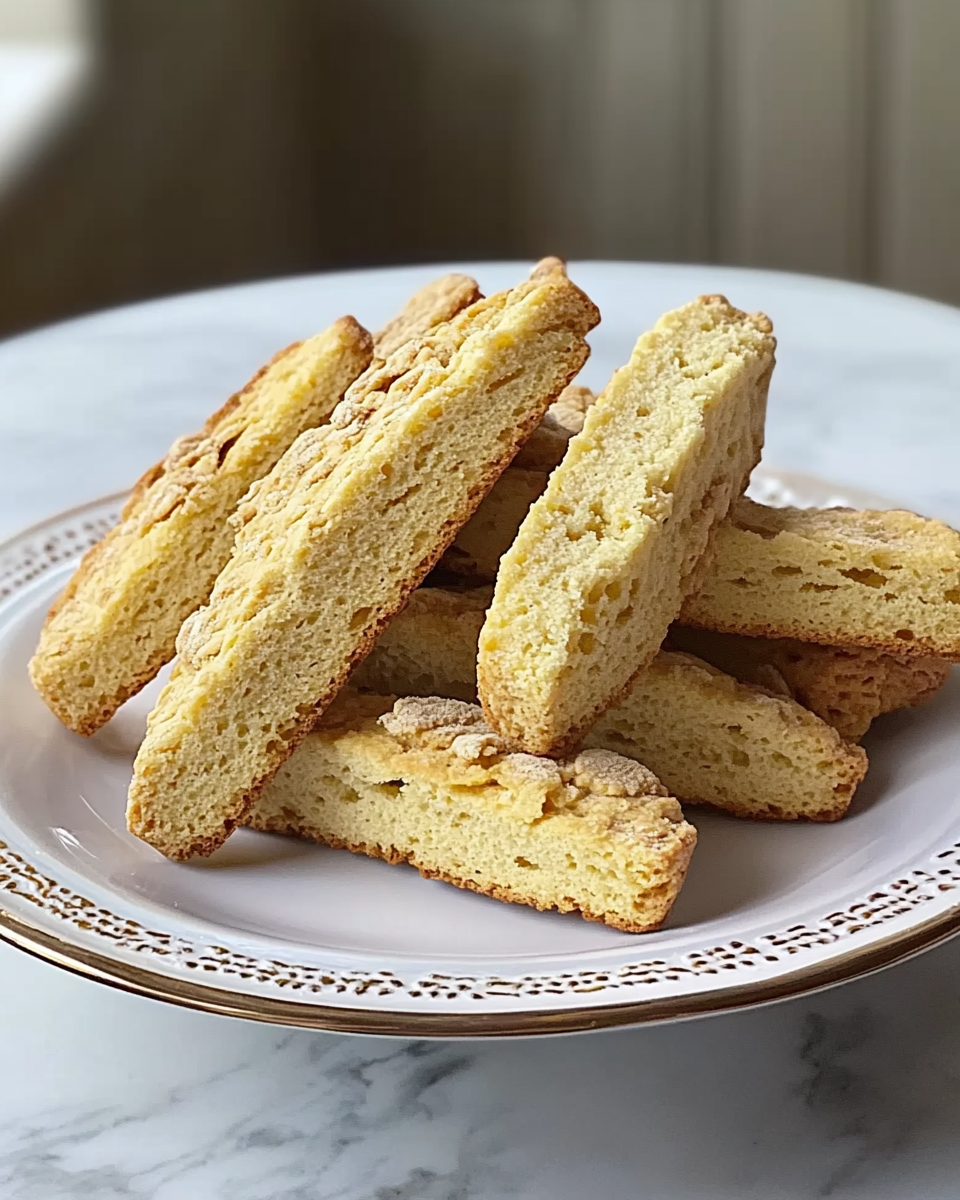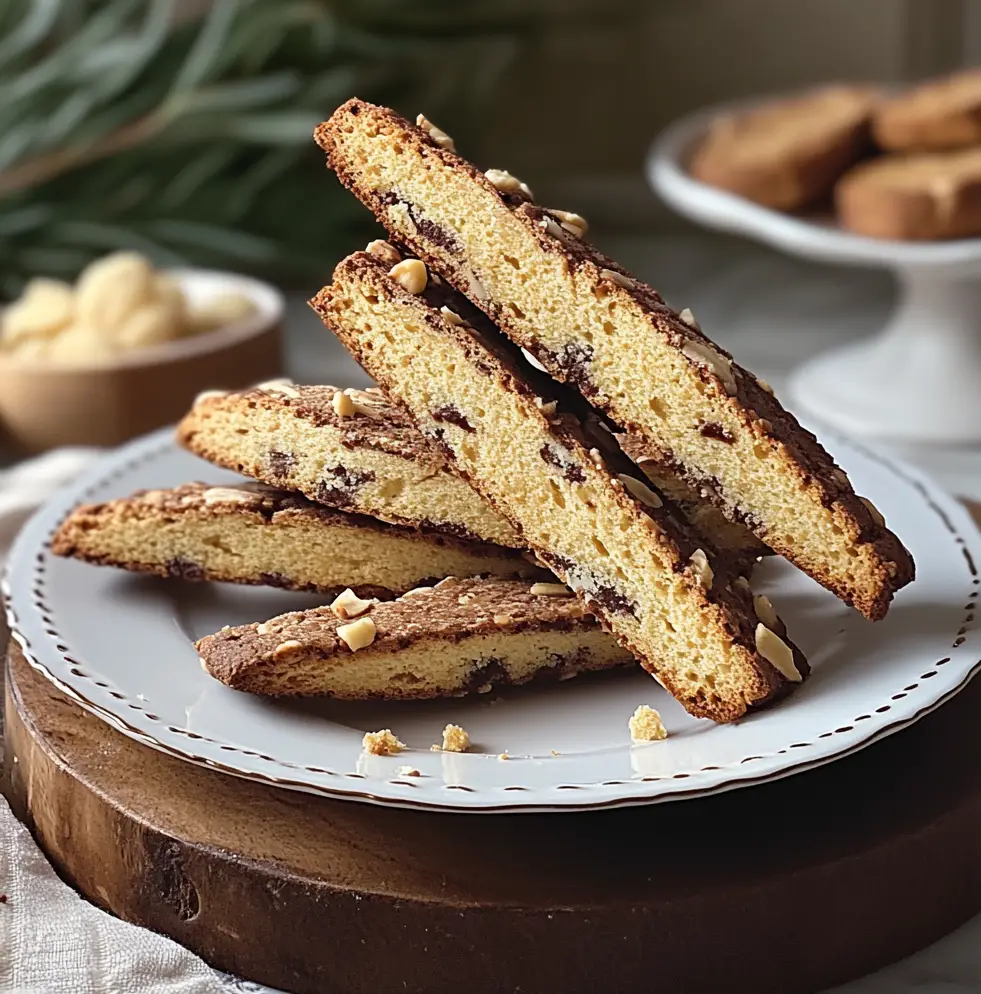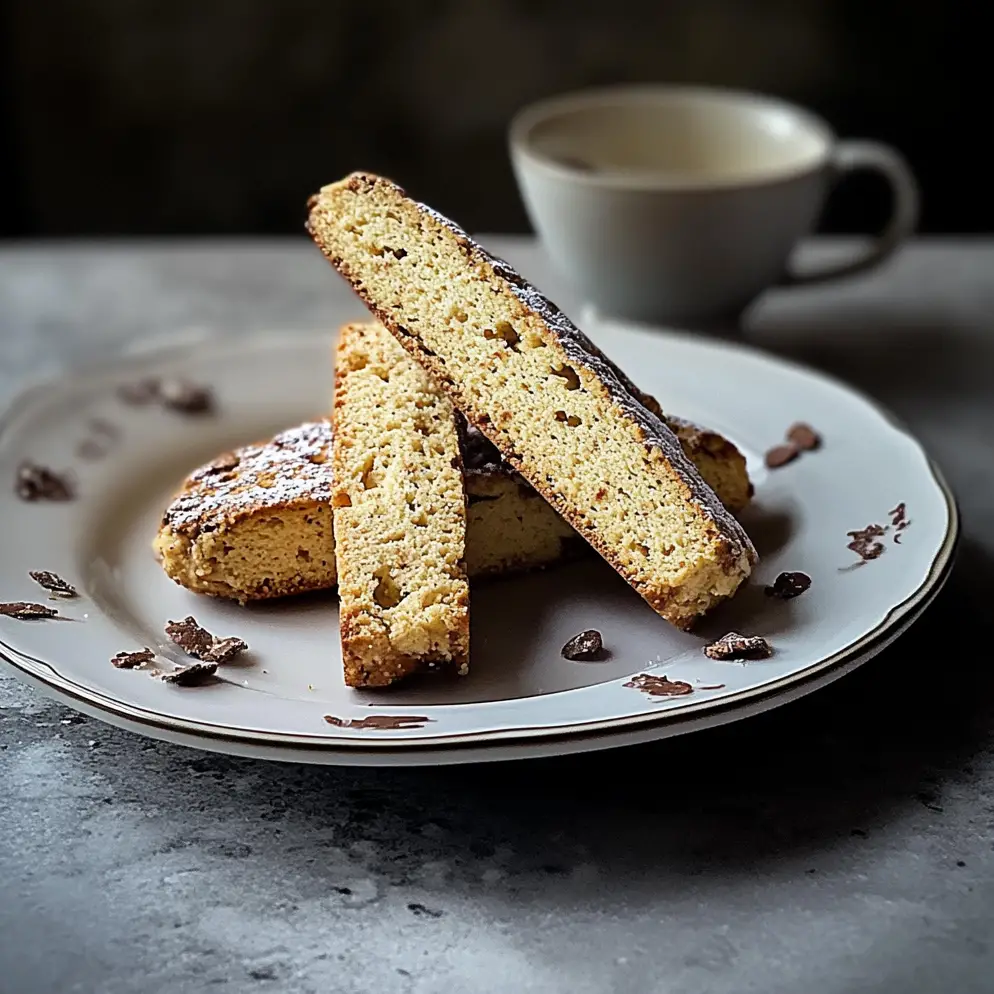Biscotti, a classic Italian twice-baked cookie, is perfect for pairing with your favorite cup of coffee or tea. Its signature crunch and subtle sweetness make it a versatile treat that can be enjoyed any time of the day. With a hint of anise for a traditional flavor, this biscotti recipe is as authentic as it gets.
Not only are these biscotti perfect for personal indulgence, but they also make an excellent homemade gift. Whether you drizzle them with chocolate or enjoy them plain, their golden crispiness and delightful texture are sure to impress. Serve them at a gathering or keep a jar on your counter for a quick and satisfying snack.
Full Recipe:
- 1 cup white sugar
- ½ cup vegetable oil
- 3 large eggs
- 1 teaspoon anise extract
- 3 ¼ cups all-purpose flour
- 1 tablespoon baking powder
Directions:
- Preheat the oven to 375°F (190°C). Grease two cookie sheets or line them with parchment paper.
- In a large bowl, mix together sugar, oil, eggs, and anise extract until well blended.
- Combine flour and baking powder in a separate bowl, then gradually mix into the wet ingredients until a dough forms.
- Divide the dough into two equal parts. Shape each into a log about 12 inches long and 2 inches wide. Place logs onto the prepared cookie sheets.
- Bake in the preheated oven for 25 to 30 minutes or until golden brown. Remove from the oven and cool for 10 minutes.
- Cut each log into ½-inch slices on a diagonal. Arrange slices cut-side down on the cookie sheets.
- Return to the oven and bake for 10 to 12 minutes on each side, or until lightly toasted.
- Cool completely before serving.
Prep Time: 20 minutes | Cooking Time: 50 minutes | Total Time: 1 hour 10 minutes
Kcal: 110 per biscotti | Servings: About 24 biscotti
Biscotti: A Timeless Italian Treat
Biscotti, the quintessential Italian cookie, holds a special place in the hearts of dessert lovers worldwide. Known for its unique twice-baked preparation, this crunchy delight is a versatile treat that pairs perfectly with coffee, tea, or even wine. In this article, we’ll delve into the rich history of biscotti, explore its diverse variations, and discuss tips for making and enjoying this beloved confection at home.
A Brief History of Biscotti
The origins of biscotti can be traced back to ancient Rome, where “bis coctum,” meaning “twice-cooked,” referred to bread baked twice for preservation. This technique produced a dry, long-lasting biscuit that could withstand long journeys, making it a staple for Roman soldiers and sailors. Over centuries, this simple survival food evolved into the elegant biscotti we know today.
Biscotti gained prominence during the Renaissance in the Italian region of Tuscany, particularly in the city of Prato. The modern version, enriched with almonds, became a favorite accompaniment to Vin Santo, a traditional sweet wine. From these humble beginnings, biscotti spread across Europe and eventually to the Americas, becoming a symbol of Italian culinary heritage.
The Unique Process of Twice-Baking
One of the defining characteristics of biscotti is its twice-baked preparation. This method not only gives biscotti its signature crisp texture but also enhances its shelf life. The first baking transforms the dough into a firm loaf, which is then sliced into individual pieces and baked again until golden and crunchy.
This double-baking technique sets biscotti apart from other cookies, making it a durable treat that can be stored for weeks without losing its charm. The process also allows for endless experimentation with flavors and ingredients, ensuring that every batch can be uniquely tailored to suit personal preferences.
Exploring Flavor Variations
While the traditional almond biscotti remains a classic, modern interpretations have introduced a variety of flavors to cater to diverse tastes. Here are a few popular variations:
- Chocolate and Hazelnut Biscotti: A decadent choice for chocolate lovers, combining the richness of cocoa with the nutty crunch of hazelnuts.
- Cranberry and Pistachio Biscotti: A visually stunning option with vibrant red cranberries and green pistachios, offering a balance of tartness and nuttiness.
- Lemon and Poppy Seed Biscotti: A zesty twist with a light and refreshing flavor profile, perfect for pairing with tea.
- Espresso Biscotti: Infused with coffee for an extra boost of caffeine and a bold, aromatic taste.
- Gluten-Free Biscotti: Made with almond or rice flour to cater to those with dietary restrictions, ensuring everyone can enjoy this timeless treat.
Perfect Pairings: How to Enjoy Biscotti
Traditionally, biscotti are served alongside a beverage for dipping, softening their crisp texture and enhancing their flavors. Here are some popular pairings:
- Coffee and Cappuccino: The robust flavor of coffee complements the subtle sweetness of biscotti, making it a favorite breakfast or afternoon snack.
- Tea: From Earl Grey to herbal infusions, tea offers a gentle counterpart to the crunchy texture of biscotti.
- Vin Santo: In Italy, biscotti and Vin Santo are a classic duo. The sweet wine’s richness pairs beautifully with the cookie’s almond undertones.
- Hot Chocolate: For a decadent treat, try dipping biscotti in creamy hot chocolate—a match made in dessert heaven.
For a creative twist, biscotti can also be crumbled over ice cream or yogurt, adding a delightful crunch to your favorite desserts.
Tips for Achieving Perfect Biscotti
Mastering the art of biscotti requires attention to detail and a few key techniques:
- Choose Quality Ingredients: Since biscotti rely on simple ingredients, their quality is paramount. Opt for fresh eggs, high-quality extracts, and premium nuts.
- Handle the Dough Carefully: Biscotti dough can be sticky, so working with slightly damp hands or dusting your surface with flour can make shaping easier.
- Slice While Warm: After the first bake, let the loaves cool slightly but not completely. This ensures clean cuts without crumbling.
- Monitor the Second Bake: Keep an eye on the biscotti during the second bake to prevent over-browning. Flip the slices halfway through for even toasting.
By following these tips, you’ll achieve the perfect balance of crunch and flavor in every batch.
The Appeal of Homemade Biscotti
Making biscotti at home allows for endless customization and creativity. Whether you’re baking for a special occasion, creating edible gifts, or simply indulging your sweet tooth, homemade biscotti offer a sense of accomplishment and a personal touch.
Home bakers also have the freedom to experiment with textures, flavors, and decorations. Drizzling biscotti with chocolate, dipping them in icing, or sprinkling them with powdered sugar can elevate their appearance and taste, making them even more enjoyable.
Health Benefits of Biscotti
While biscotti are undoubtedly a treat, they also come with some surprising health benefits. Thanks to their twice-baked preparation, biscotti are lower in fat compared to many other cookies. Variations with nuts, seeds, or whole grains add a dose of healthy fats, protein, and fiber, making them a relatively wholesome option for snacking.
Portion control is another advantage of biscotti. Their firm texture encourages mindful eating, as they are typically enjoyed one at a time alongside a beverage.
The Global Popularity of Biscotti
Biscotti’s appeal transcends borders, with adaptations found in various cultures. For instance, the French have their own version called “croquets,” while the Jewish community enjoys “mandelbrot,” a similar twice-baked cookie made with almonds. Each variation reflects the unique flavors and traditions of its region while maintaining the core essence of biscotti.
This global presence highlights the versatility and universal charm of biscotti, which continues to inspire bakers and delight taste buds around the world.
Conclusion: A Timeless Treat for Every Occasion
Biscotti’s enduring popularity lies in its simplicity, versatility, and rich history. From its humble beginnings as a practical food for travelers to its status as a beloved dessert, biscotti have stood the test of time. Whether you prefer the classic almond flavor or enjoy experimenting with modern variations, biscotti offer something for everyone.
The joy of baking and sharing biscotti extends beyond the kitchen, bringing people together over coffee, tea, or wine. With their long shelf life and customizable nature, biscotti are perfect for gifting, entertaining, or savoring in quiet moments.
By embracing the art of biscotti-making, you’re not just creating a cookie—you’re preserving a piece of culinary history and crafting a treat that connects past traditions with present-day indulgence.
Print
Biscotti
- Total Time: 1 hour 10 minutes
Description
Biscotti, a classic Italian twice-baked cookie, is perfect for pairing with your favorite cup of coffee or tea. Its signature crunch and subtle sweetness make it a versatile treat that can be enjoyed any time of the day. With a hint of anise for a traditional flavor, this biscotti recipe is as authentic as it gets.
Not only are these biscotti perfect for personal indulgence, but they also make an excellent homemade gift. Whether you drizzle them with chocolate or enjoy them plain, their golden crispiness and delightful texture are sure to impress. Serve them at a gathering or keep a jar on your counter for a quick and satisfying snack.
Ingredients
- 1 cup white sugar
- 1/2 cup vegetable oil
- 3 large eggs
- 1 teaspoon anise extract
- 3 1/4 cups all-purpose flour
- 1 tablespoon baking powder
Instructions
- Preheat the oven to 375°F (190°C). Grease two cookie sheets or line them with parchment paper.
- In a large bowl, mix together sugar, oil, eggs, and anise extract until well blended.
- Combine flour and baking powder in a separate bowl, then gradually mix into the wet ingredients until a dough forms.
- Divide the dough into two equal parts. Shape each into a log about 12 inches long and 2 inches wide. Place logs onto the prepared cookie sheets.
- Bake in the preheated oven for 25 to 30 minutes or until golden brown. Remove from the oven and cool for 10 minutes.
- Cut each log into ½-inch slices on a diagonal. Arrange slices cut-side down on the cookie sheets.
- Return to the oven and bake for 10 to 12 minutes on each side, or until lightly toasted.
- Cool completely before serving.
- Prep Time: 20 minutes
- Cook Time: 50 minutes








